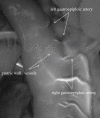Visualization of blood supply route to the reconstructed stomach by indocyanine green fluorescence imaging during esophagectomy
- PMID: 24885891
- PMCID: PMC4041049
- DOI: 10.1186/1471-2342-14-18
Visualization of blood supply route to the reconstructed stomach by indocyanine green fluorescence imaging during esophagectomy
Abstract
Background: Ensuring an adequate blood supply is essential to the safe performance of an anastomosis during esophagectomy and the prevention of anastomotic leakage. Recently, indocyanine green (ICG) fluorescence imaging has been used to visualize the blood supply when anastomosis is performed in vascular surgery. We used ICG fluorescence imaging to visualize the blood supply for reconstruction during esophagectomy.
Methods: Since January 2009, we have performed ICG fluorescence imaging in 33 patients with thoracic esophageal cancer who underwent thoracic esophagectomy. After pulling up the reconstructed stomach, 2.5 mg of ICG was injected as a bolus. ICG fluorescence imaging was performed with a near-infrared camera, and the images were recorded.
Results: ICG fluorescence was easily detected in all patients 1 min after injection. Vascular networks were well visualized in the gastric wall and omentum. The blood supply route was located in the greater omentum beside the splenic hilum in 22 (66.7%) of the 33 patients.
Conclusions: ICG fluorescence can be used to evaluate the blood supply to the reconstructed stomach in patients undergoing esophagectomy for esophageal cancer. On ICG fluorescence imaging, the splenic hiatal vessels were the major blood supply for the anastomosis in most patients.
Figures




References
-
- Standring S. In: Abdominal oesophagus and stomach. 40. Borley NR, editor. London: Elsevier; 2008. Gray’s anatomy: The anatomical basis of clinical practice; pp. 1111–1123.
MeSH terms
Substances
LinkOut - more resources
Full Text Sources
Other Literature Sources
Medical

